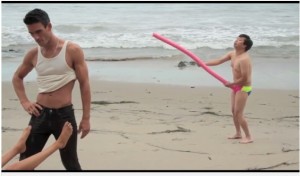As a result of this project, I have been thinking a lot about fashion magazines, including men’s magazines. So when someone on Facebook shared this video, it immediately caught my eye. It is a GQ.com post about Ken Jeong photobombing Kate Upton. Before I’ve even had my morning coffee, I find myself contemplating raced and aged bodies, the artificiality of photoshoots, and all sorts of other things.
http://www.gq.com/video/videos/ken-jeong-kate-upton-photobomb-video [expired video]
Jeong is clearly leading us on, asking us to believe that he was not invited. In fact, the multiple takes of his jump into the pool, wearing different shorts each time, suggest that the folks at GQ are having a laugh.
But what is it about the video that makes it funny? Pulling from Naomi Woolf’s The Beauty Myth, the main source of yuks is that Jeong is intruding into the creation of beauty pornography, causing a humorous disjunction. He is not supposed to be there. But why does his intrusion cause laughs rather than ramping up the sexual tension? For instance, even when Jeong is in bed with the couple, the viewer is never led to believe that this could turn into a menage à trois. If you think I am making too much of it, consider how the screen capture below would be different if it were the male model posing as Jeong does

There are two factors that account for the humor in the video. The first, and less insidious of the two, is that he calls our attention to the absurdity of this type of image. Note the moment at around 01:00 when Jeong playfully bites his own bra strap. It looks ridiculous on him, but it is not at all inconceivable that we might see a shot of a woman doing this in any number of men’s or fashion magazines (commentary about a woman consuming the accoutrements of her own sexuality will have to be saved for another post).
So why does it look ridiculous on him? Setting aside the issue of him being a man wearing a woman’s undergarments, it looks absurd because we are supposed to assume that he is disrupting the sexiness of the photos. Because he is not sexy. The incongruity of his raced and aged body is so far outside of pop culture’s sexual ideal, that his intrusion is assumed to be humorous. His actions with the pool noodle are coded as playful and silly when in fact they are quite lewd and suggestive. There is a long history of the desexualized Asian man in American popular culture (think Long Duc Dong, any Jackie Chan character, Jeong’s own role in The Hangover movies, etc), which allows Jeong to act suggestively to humorous effect. The additional layering of the realities of an aging body additionally obscure his sexuality and add to the humor. He is not supposed to be there because he was not invited, but also because he is not conventionally sexy.
I find it interesting that though the post at GQ is over a month old, there is just one comment. It is someone who thinks the video is hilarious. My intention here is not to deny that the video is humorous. I laughed. But I had barely caught my breath before I was thinking about how the humor was operating and wondering what this representation of middle-aged Asian male sexuality is doing as it circulates, particularly in juxtaposition with Upton and the male model. Though the humor draws upon certain stereotypes, there is an opportunity here. The opportunity is for us to reflect on Jeong’s disruption as calling our attention to the narrow definition of sexually desirable bodies as articulated by pop culture.
The video itself is interesting because it places Jeong in the position of the speaking subject. He is the narrator and is positioned as being in power because he is engaging in mischievous disruption of the photo shoot. It will be interesting to see how the still images compare. For all I know, they are for a feature about Jeong. We are seeing more and more of this trend in magazine photoshoots – the pre-release of a video while we wait for the still photo spread to hit news stands. Just one of the ways in which print publications are leveraging emerging media forms. The still photos and any accompanying commentary have the possibility of taking this story in multiple directions. We just have to wait and see.
For more reading on representations of Asian men in popular culture, see Karen Chau’s guest post at Racialicious.

Leave a Reply
You must be logged in to post a comment.